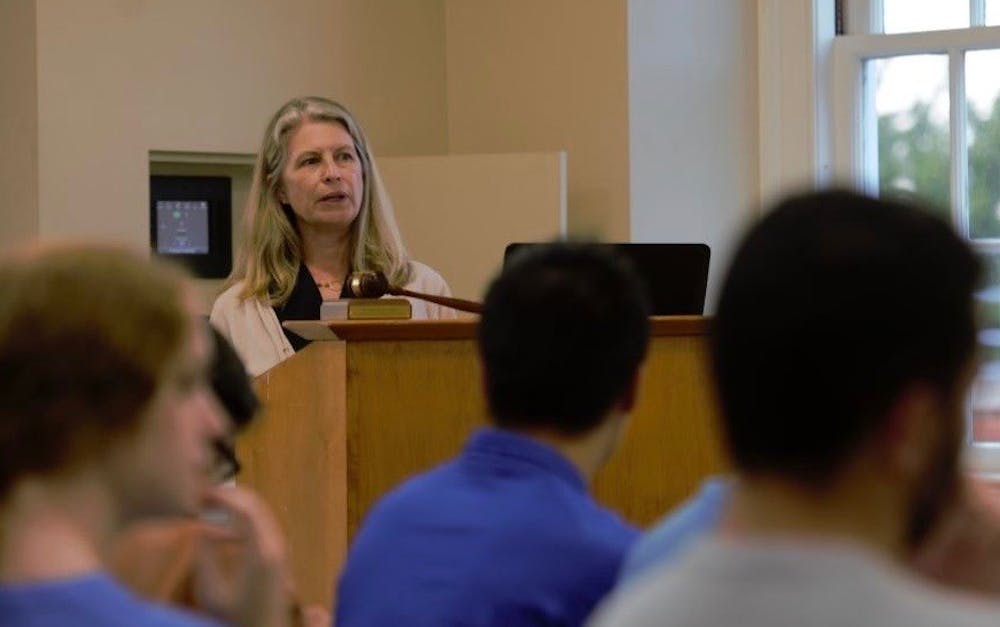As part of an ongoing process to increase public engagement around the University’s finances and tuition costs, Melody Stowe Bianchetto, U.Va.’s vice president for finance, presented an overview of the University’s $1.8 billion budget for the 2018-19 fiscal year to the Student Council at its meeting Tuesday evening.
Bianchetto said that her presentation was at the request of Alex Cintron, a fourth-year College student and Student Council president.
“One of the reasons I’m here tonight is to give you an overview as we enter into the budget and tuition setting process at the University,” Bianchetto said. “This is pretty new for us. Alex came in and approached us over the summer, and he wanted to get more transparency about how we’re making decisions and how budget priorities are identified.”
Bianchetto then gave an overview of the budget, explaining the sources and planned uses of funding. The sources of funding included tuition and fees, externally supported research, state appropriations, the endowment distribution, expensable gifts and sales and services and others.
Bianchetto also offered brief explanations of each of the sources of funding. In particular, she explained that although the endowment distribution accounts for over $214 million, the University only spends five percent of those funds annually and invests the remainder.
The University’s endowment serves as a pool of funds with the primary purpose of investment to increase returns on the money and subsequently fund scholarships or endowed professorships, among other things. Last year, the University’s endowment was $8.6 billion but has increased to $9.5 billion in 2018. Most recently, the endowment’s best-performing area of investment, private equity, reaped a gross 22.9 percent for the fiscal year.
“We have an endowment, but we do not spend the balance of the endowment,” Bianchetto said. “Think of the endowment like a big savings account. We are investing it. We only spend about five percent of the endowment every year, that’s to make sure that 50 years from now, 100 years from now, there will still be an endowment that can go toward the operations of the institution.”
Bianchetto then explained where the other funds are allocated. Total expenditures for the 2018-19 fiscal year is $1,804,818,000. Nearly $500 million goes toward direct instruction, which accounts for faculty salaries and classroom equipment. Over $441 million goes toward research and public service; over $247 million goes toward Deans, Libraries and Academic Technologies; and over $50 million goes toward the University Registrar, the Dean of Students and Student Financial Services.
Operating and Maintaining Facilities, Financial Aid and Auxiliaries — including athletics, housing, dining — account for the remainder of the expenditures.
After Bianchetto’s presentation concluded, she opened up the floor to questions, comments and concerns from the representatives.
Avery Gagne, a second-year College student and representative, asked a question about diverse faculty hires.
“There really is, in my opinion, a need for diverse faculty,” Gagne said. “I just wanted to know, when you’re considering hiring diverse faculty, are those professors also going to be teaching general topics courses?”
Bianchetto responded that the University believed that increasing diversity generally was a priority.
“I would say that the priority is just in general to increase the diversity,” Bianchetto said. “We’re trying to raise some funds, create some named professorships so that we can go out and recruit some of the best across the board. That’s a very good point that I’ll make note of.”
Amr Metwally, a second-year College student and representative, asked about the potential of a tuition freeze.
“Is the concept of a tuition freeze being brought up, where you pay the same amount for four years?” Metwally asked.
Bianchetto responded that the University does offer a fixed-rate tuition plan, but that it has not been popular recently.
“We do have an optional guarantee plan with a rate that’s the same for the next four years,” Bianchetto responded. “We have kept our in-state tuition rates at 2.2, 2.5 percent recently, and so that hasn’t been as popular.”
According to the Tuition and Budget Proposal Timeline that Bianchetto presented, the next step is for schools and units to turn in their tuition requests on Oct. 12. Later in October, a preliminary tuition proposal will be developed.
At a meeting of the University’s Board of Visitors last month, Vice Rector James B. Murray Jr. said the Board will discuss tuition more in-depth during its December meeting amid concerns over the possibility of a state-initiated tuition hike. The University also hosted a public hearing regarding tuition last month and plans to hold another session in November.







